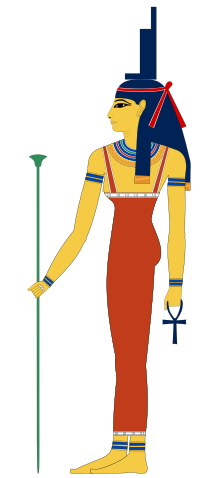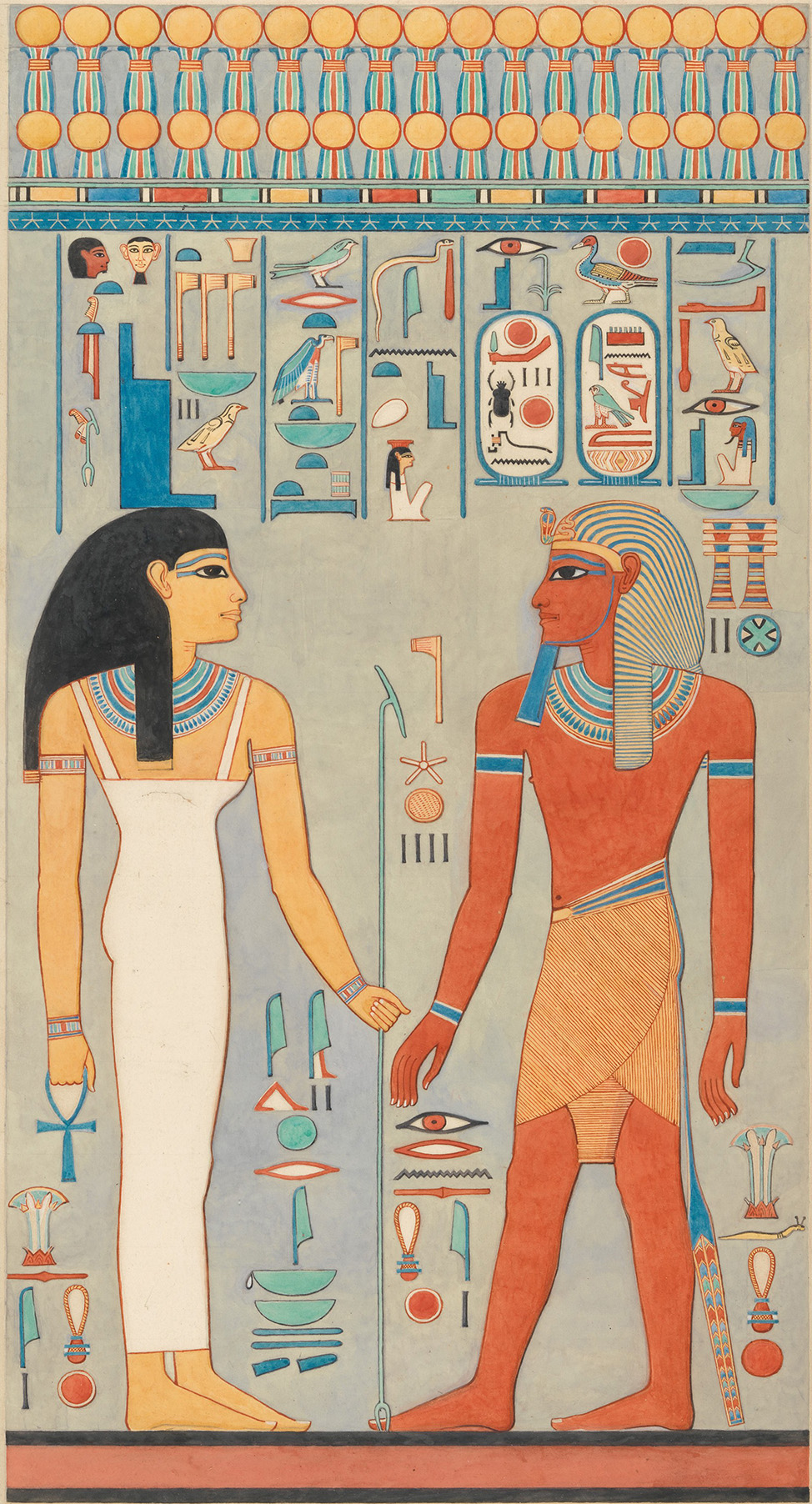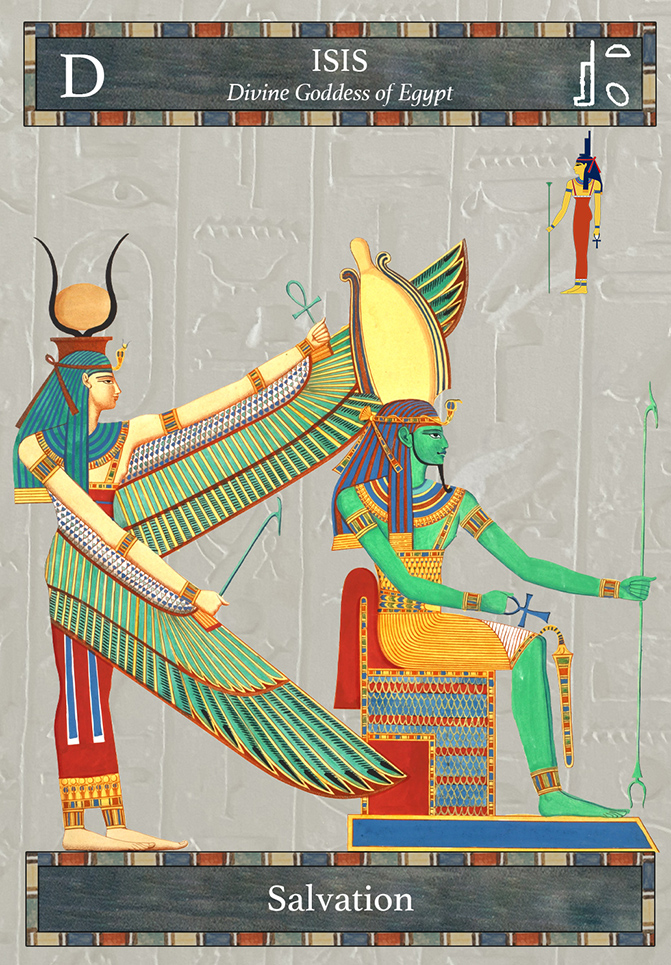Isis
Isis (Ancient Egyptian: 𓊨𓏏𓆇𓁐, romanized: Ꜣūsat) was a major goddess in ancient Egyptian religion whose worship spread throughout the Greco-Roman world. Isis was first mentioned in the Old Kingdom (c. 2686 – c. 2181 BCE) as one of the main characters of the Osiris myth, in which she resurrects her slain brother and husband, the divine king Osiris, and produces and protects his heir, Horus.
She was believed to help the dead enter the afterlife as she had helped Osiris, and she was considered the divine mother of the pharaoh, who was likened to Horus. Her maternal aid was invoked in healing spells to benefit ordinary people. Originally, she played a limited role in royal rituals and temple rites, although she was more prominent in funerary practices and magical texts. She was usually portrayed in art as a human woman wearing a throne-like hieroglyph on her head. During the New Kingdom (c. 1550 – c. 1070 BCE), as she took on traits that originally belonged to Hathor, the preeminent goddess of earlier times, Isis was portrayed wearing Hathor's headdress: a sun disk between the horns of a cow.
Origins
Whereas some Egyptian deities appeared in the late Predynastic Period (before c. 3100 BCE), neither Isis nor her husband Osiris were mentioned by name before the Fifth Dynasty (c. 2494–2345 BCE). An inscription that may refer to Isis dates to the reign of Nyuserre Ini during that period, and she appears prominently in the Pyramid Texts, which began to be written down at the end of the dynasty and whose content may have developed much earlier. Several passages in the Pyramid Texts link Isis with the region of the Nile Delta near Behbeit el-Hagar and Sebennytos, and her cult may have originated there.
Isis is part of the Ennead of Heliopolis, a family of nine deities descended from the creator god, Atum or Ra. She and her siblings—Osiris, Set, and Nephthys—are the last generation of the Ennead, born to Geb, god of the earth, and Nut, goddess of the sky. The creator god, the world's original ruler, passes down his authority through the male generations of the Ennead, so that Osiris becomes king. Isis, who is Osiris's wife as well as his sister, is his queen.
Name
Many scholars have focused on Isis's name in trying to determine her origins. Her Egyptian name was written as 𓊨𓏏𓆇𓁐 (ꜣst) and was pronounced Ꜣūsat, which became ⲎⲤⲈ (Ēse) in the Coptic form of Egyptian, Wusa in the Meroitic language of Nubia, and Ἶσις, on which her modern name is based, in Greek. The hieroglyphic writing of her name incorporates the sign for a throne, which Isis also wears on her head as a sign of her identity. The symbol serves as a phonogram, spelling the st sounds in her name, but it may have also represented a link with actual thrones. The Egyptian term for a throne was also st and may have shared a common etymology with Isis's name.
Egyptologist Kurt Sethe suggested she was originally a personification of thrones. Henri Frankfort agreed, believing that the throne was considered the king's mother, and thus a goddess, because of its power to make a man into a king. Other scholars, such as Jürgen Osing and Klaus P. Kuhlmann, have disputed this interpretation, because of dissimilarities between Isis's name and the word for a throne or a lack of evidence that the throne was ever deified.
Roles
Isis' two primary roles in ancient Egyptian religion are that of a protective mother and that of a divine queen.
She was treated as the mother of Horus even in the earliest copies of the Pyramid Texts. Yet there are signs that Hathor was originally regarded as his mother, and other traditions make an elder form of Horus the son of Nut and a sibling of Isis and Osiris. Isis may only have come to be Horus's mother as the Osiris myth took shape during the Old Kingdom, but through her relationship with him she came to be seen as the epitome of maternal devotion. In the developed form of the myth, Isis gives birth to Horus, after a long pregnancy and a difficult labor, in the papyrus thickets of the Nile Delta. As her child grows she must protect him from Set and many other hazards—snakes, scorpions, and simple illness.
Horus was equated with each living pharaoh and Osiris with the pharaoh's deceased predecessors. Isis was therefore the mythological mother and wife of kings. In the Pyramid Texts her primary importance to the king was as one of the deities who protected and assisted him in the afterlife. Her prominence in royal ideology grew in the New Kingdom. Temple reliefs from that time on show the king nursing at Isis's breast; her milk not only healed her child, but symbolized his divine right to rule. Royal ideology increasingly emphasized the importance of queens as earthly counterparts of the goddesses who served as wives to the king and mothers to his heirs.
Isis was also known for her magical power, which enabled her to revive Osiris and to protect and heal Horus, and for her cunning. By virtue of her magical knowledge, she was said to be "more clever than a million gods." In several episodes in the New Kingdom story The Contendings of Horus and Set, Isis uses these abilities to outmaneuver Set during his conflict with her son. On one occasion, she transforms into a young woman who tells Set she is involved in an inheritance dispute similar to Set's usurpation of Osiris's crown. When Set calls this situation unjust, Isis taunts him, saying he has judged himself to be in the wrong. In later texts, she uses her powers of transformation to fight and destroy Set and his followers.
Like other deities throughout Egyptian history, Isis had many forms in her individual cult centers, and each cult center emphasized different aspects of her character. Local Isis cults focused on the distinctive traits of their deity more than on her universality, whereas some Egyptian hymns to Isis treat other goddesses in cult centers from across Egypt and the Mediterranean as manifestations of her.
Sky goddess
Many of the roles Isis acquired gave her an important position in the sky. Passages in the Pyramid Texts connect Isis closely with Sopdet, the goddess representing the star Sirius, whose relationship with her husband Sah—the constellation Orion—and their son Sopdu parallels Isis's relations with Osiris and Horus. Sirius's heliacal rising, just before the start of the Nile flood, gave Sopdet a close connection with the flood and the resulting growth of plants. Partly because of her relationship with Sopdet, Isis was also linked with the flood, which was sometimes equated with the tears she shed for Osiris.
By Ptolemaic times she was connected with rain, which Egyptian texts call a "Nile in the sky"; with the sun as the protector of Ra's barque; and with the moon, possibly because she was linked with the Greek lunar goddess Artemis by a shared connection with an Egyptian fertility goddess, Bastet. In hymns inscribed at Philae she is called the "Lady of Heaven" whose dominion over the sky parallels Osiris's rule over the Duat and Horus's kingship on earth.
Iconography
In Ancient Egyptian art, Isis was most commonly depicted as a woman with the typical attributes of a goddess: a sheath dress, a staff of papyrus in one hand, and an ankh sign in the other. Her original headdress was the throne sign used in writing her name. She and Nephthys often appear together, particularly when mourning Osiris's death, supporting him on his throne, or protecting the sarcophagi of the dead. In these situations their arms are often flung across their faces, in a gesture of mourning, or outstretched around Osiris or the deceased as a sign of their protective role.
Beginning in the New Kingdom, thanks to the close links between Isis and Hathor, Isis took on Hathor's attributes, such as a sistrum rattle and a headdress of cow horns enclosing a sun disk. Sometimes both headdresses were combined, so the throne glyph sat atop the sun disk. In the same era, she began to wear the insignia of a human queen, such as a vulture-shaped crown on her head and the royal uraeus, or rearing cobra, on her brow.
In Ptolemaic and Roman times, statues and figurines of Isis often showed her in a Greek sculptural style, with attributes taken from Egyptian and Greek tradition. Some of these images reflected her linkage with other goddesses in novel ways. Isis-Thermuthis, a combination of Isis and Renenutet who represented agricultural fertility, was depicted in this style as a woman with the lower body of a snake. Figurines of a woman wearing an elaborate headdress and exposing her genitals may represent Isis-Aphrodite.
The tyet symbol, a looped shape similar to the ankh, came to be seen as Isis's emblem at least as early as the New Kingdom, though it existed long before. It was often made of red jasper and likened to Isis's blood. Used as a funerary amulet, it was said to confer her protection on the wearer.
Festivals
Roman calendars listed the two most important festivals of Isis as early as the first century CE. The first festival was the Navigium Isidis in March, which celebrated Isis's influence over the sea and served as a prayer for the safety of seafarers and, eventually, of the Roman people and their leaders. It consisted of an elaborate procession, including Isiac priests and devotees with a wide variety of costumes and sacred emblems, carrying a model ship from the local Isis temple to the sea or to a nearby river. The other was the Isia in late October and early November. Like its Egyptian forerunner, the Khoiak festival, the Isia included a ritual reenactment of Isis's search for Osiris, followed by jubilation when the god's body was found. Several more minor festivals were dedicated to Isis, including the Pelusia in late March that may have celebrated the birth of Harpocrates, and the Lychnapsia, or lamp-lit festival, that celebrated Isis's own birth on August 12.
Festivals of Isis and other polytheistic deities were celebrated throughout the fourth century CE, despite the growth of Christianity in that era and the persecution of pagans that intensified toward the end of the century. The Isia was celebrated at least as late as 417 CE, and the Navigium Isidis lasted well into the sixth century. Increasingly, the religious meaning of all Roman festivals was forgotten or ignored even as the customs continued. In some cases, these customs became part of the combined classical and Christian culture of the Early Middle Ages.
Legacy
From the Renaissance on, the veiled statue of Isis that Plutarch and Proclus mentioned was interpreted as a personification of nature, based on a passage in the works of Macrobius in the fifth century CE that equated Isis with nature. Authors in the seventeenth and eighteenth centuries ascribed a wide variety of meanings to this image. Isis represented nature as the mother of all things, as a set of truths waiting to be unveiled by science, as a symbol of the pantheist concept of an anonymous, enigmatic deity who was immanent within nature, or as an awe-inspiring sublime power that could be experienced through ecstatic mystery rites.
In the dechristianization of France during the French Revolution, she served as an alternative to traditional Christianity: a symbol that could represent nature, modern scientific wisdom, and a link to the pre-Christian past. For these reasons, Isis's image appeared in artwork sponsored by the revolutionary government, such as the Fontaine de la Régénération, and by the First French Empire. The metaphor of Isis's veil continued to circulate through the nineteenth century. Helena Blavatsky, the founder of the esoteric Theosophical tradition, titled her 1877 book on Theosophy Isis Unveiled, implying that it would reveal spiritual truths about nature that science could not.
Among modern Egyptians, Isis was used as a national symbol during the Pharaonism movement of the 1920s and 1930s, as Egypt gained independence from British rule. In works such as Mohamed Naghi's painting in the parliament of Egypt, titled Egypt's Renaissance, and Tawfiq al-Hakim's play The Return of the Spirit, Isis symbolizes the revival of the nation. A sculpture by Mahmoud Mokhtar, also called Egypt's Renaissance, plays upon the motif of Isis's removing her veil.
Isis is found frequently in works of fiction, such as a superhero franchise, and her name and image appear in places as disparate as advertisements and personal names. The name Isidoros, meaning "gift of Isis" in Greek, survived in Christianity despite its pagan origins, giving rise to the English name Isidore and its variants.In the late twentieth and early twenty-first centuries, "Isis" itself became a popular feminine given name.
Modern worship
Isis continues to appear in modern esoteric and pagan belief systems. The concept of a single goddess incarnating all feminine divine powers, partly inspired by Apuleius, became a widespread theme in literature of the nineteenth and early twentieth centuries.
Influential groups and figures in esotericism, such as the Hermetic Order of the Golden Dawn in the late nineteenth century and Dion Fortune in the 1930s, adopted this all-encompassing goddess into their belief systems and called her Isis. This conception of Isis influenced the Great Goddess found in many forms of contemporary witchcraft. The Golden Dawn's philosophy concerning Isis greatly influenced the meanings of The High Priestess Tarot card.
Today, reconstructions of ancient Egyptian religion, such as Kemetic Orthodoxy or the Church of the Eternal Source, include Isis among the deities they revere. An eclectic religious organization focused on female divinity calls itself the Fellowship of Isis because, in the words of one of its priestesses, M. Isidora Forrest, Isis can be "all Goddesses to all people."


